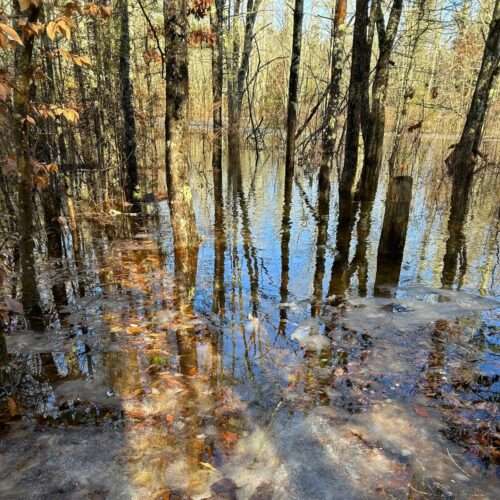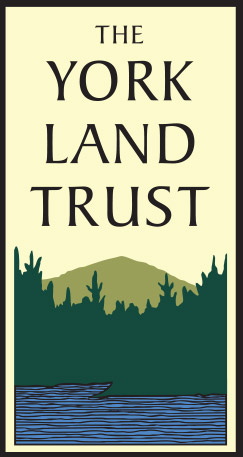
A flooded boardwalk at Hilton Winn Preserve. Photo by Jon McKenney.
The first weeks of the new year brought Maine a series of storms and rain events that devastated Maine’s coastal and island communities. York was one of 8 counties in which a State of Civil Emergency was declared. Coastal residences, businesses and working waterfronts all suffered a sizable amount of damage. Impacts to our trails and natural environment are evident throughout our public preserves as well. High winds and heavy precipitation have brought blowdowns, flooding in low-lying areas, and treacherous river crossings to our trails. You can now report issues you see out on the trails using the new “Trail Issue Report” on our website. This allows our staff to respond to issues on our trails expediently and maintain safe public access to these valuable outdoor spaces.
Although our ecosystems benefit from occasional disturbances, climate change is causing increasingly erratic weather patterns, floods, drought cycles, and issues like increased invasive species and disease. All these stressors threaten to push our ecosystems beyond their capacity to adapt and overcome. When a preserve is under stress from climate related challenges, we will often actively manage the property to alleviate these stresses, and foster ecosystem resilience. Active stewardship for climate adaptation can range from selective timber harvests, aiming to address impacts of disease and increase tree species diversity, to salt marsh restoration work. Salt marsh restoration aims to restore function to coastal marshes impacted by human uses such as agricultural management or development. Not only does active stewardship help restore function to the singular ecosystem, but it allows these areas to work as part of a larger functioning landscape.
Without active stewardship, these properties struggle to adapt, and our community loses key ecosystem services that we all depend on. Our ecosystems provide us with clean air, clean water, food, various public health benefits and much more. During storm events, we depend on our natural environment’s capacity to mitigate floodwaters. According to NOAA, our salt marshes decrease storm damage to adjacent communities by up to 20 percent. Healthy forests, salt marshes and wetlands also serve the important role of sequestering carbon and reducing our state’s contributions to climate change. In Maine, our forests sequester nearly 70 percent of our state’s gross greenhouse gas emissions. Salt marshes are even more efficient carbon sinks, storing 1.7 million metric tons of carbon in Maine every year. Our efforts in conserving and caring for land in the coming years will have a direct, quantifiable impact on the severity of flooding and storm damage in York and its cost to residents. If we as a community come together to support our outdoor spaces in this time of rapid change, our outdoor spaces will continue to support our community through the future storms we weather.

 MAKE A GIFT
MAKE A GIFT SUBSCRIBE
SUBSCRIBE TRAIL MAPS
TRAIL MAPS CONTACT US
CONTACT US MEMBERSHIP
MEMBERSHIP